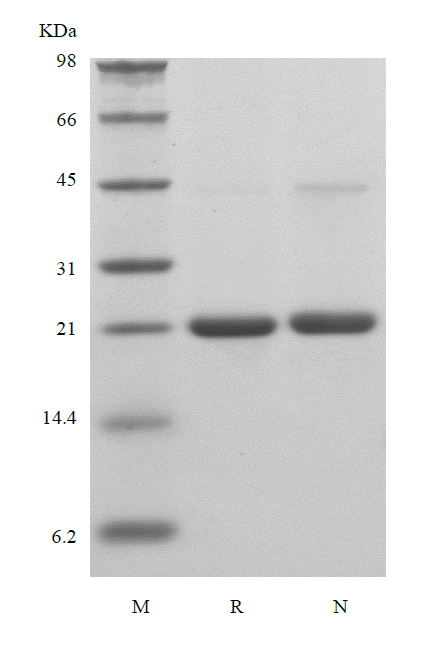- Synonyms
- SHH, HHG-1
- Source
- Escherichia coli.
- Molecular Weight
- Approximately 19.8 kDa, a single non-glycosylated polypeptide chain containing 176 amino acids.
- AA Sequence
- IVIGPGRGFG KRRHPKKLTP LAYKQFIPNV AEKTLGASGR YEGKITRNSE RFKELTPNYN PDIIFKDEEN TGADRLMTQR CKDKLNALAI SVMNQWPGVK LRVTEGWDED GHHSEESLHY EGRAVDITTS DRDRSKYGML ARLAVEAGFD WVYYESKAHI HCSVKAENSV AAKSGG
- Purity
- > 95 % by SDS-PAGE and HPLC analyses.
- Biological Activity
- Fully biologically active when compared to standard. The ED50 as determined by inducing alkaline phosphatase production of murine C3H10T1/2 cells is 0.5 - 1.0 μg/ml.
- Physical Appearance
- Sterile Filtered White lyophilized (freeze-dried) powder.
- Formulation
- Lyophilized from a 0.2 μm filtered concentrated solution in PBS, pH 7.4.
- Endotoxin
- Less than 1 EU/μg of rMuSHH as determined by LAL method.
- Reconstitution
- We recommend that this vial be briefly centrifuged prior to opening to bring the contents to the bottom. Reconstitute in sterile distilled water or aqueous buffer containing 0.1 % BSA to a concentration of 0.1-1.0 mg/ml. Stock solutions should be apportioned into working aliquots and stored at ≤ -20 °C. Further dilutions should be made in appropriate buffered solutions.
- Stability & Storage
- Use a manual defrost freezer and avoid repeated freeze-thaw cycles.
- 12 months from date of receipt, -20 to -70 °C as supplied.
- 1 month, 2 to 8 °C under sterile conditions after reconstitution.
- 3 months, -20 to -70 °C under sterile conditions after reconstitution.
- Usage
- This material is offered by Shanghai PrimeGene Bio-Tech for research, laboratory or further evaluation purposes. NOT FOR HUMAN USE.
- SDS-PAGE

- Reference
- 1. Currie PD, Ingham PW. 1996. Nature. 382:452-5.
2. Herzog W, Zeng X, Lele Z, et al. 2003. Dev Biol. 254:36-49.
3. Lewis KE, Eisen JS. 2001. Development. 128:3485-95.
4. Scholpp S, Wolf O, Brand M, et al. 2006. Development. 133:855-64.
5. Dassule HR, Lewis P, Bei M, et al. 2000. Development. 127:4775-85.
6. Porter JA, Young KE, Beachy PA. 1996. Science. 274:255-9.
- Background
- Sonic hedgehog is one of three proteins in the mammalian signaling pathway family called hedgehog, the others being desert hedgehog (DHH) and indian hedgehog (IHH). As the hh homologues, SHH has been found to have the most critical roles in development. It acts as a morphogen involved in patterning many systems, including the limb and midline structures in the brain, spinal cord, the thalamus by the zona limitans intrathalamica and the teeth. There SHH undergoes auto-processing to generate a 20 kDa (residues 24 - 197) N-terminal signaling domain (SHH-N) and a 25 kDa (residues 198 - 462) C-terminal domain with no known signaling role.








 COA Application
COA Application


